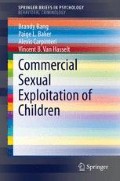Abstract
Child prostitution is defined as the coercion of a minor to perform sexual acts in exchange for money or barter. The total number of children engaged in prostitution worldwide is estimated at nearly 10 million. Domestically, child prostitution is a growing concern. Not only has there been an influx of minors trafficked into the USA for sex, but so too is the number of American youth being coerced into the sex trade. Not only has there been an influx of minors trafficked into the USA for sex, but the number of American youth being coerced into the sex is also rapidly increasing. The research does not truly differentiate between those offenders who organize and promote child prostitution and those who are consumers of child prostitution. In general, offenders can either be situational or preferential. Situational offenders tend to be less educated and come from lower socioeconomic groups. Their offending results from a need to satisfy a basic drive, and as such, they commonly do not target a particular victim population. Conversely, preferential offenders tend to be smarter and come from higher socioeconomic groups. As their label suggests, they have a very specific type of victim which they target, whether that be an age group or gender. Their other demographic characteristics vary from ages 20s to 60s and from blue-collar workers to professionals. Victims may be filtered into prostitution through trafficking. However, children can also be targeted and groomed by offenders due to their lack of familial ties or weak connections to the community. Victims of child prostitution tend to lack the education, skills, and financial means necessary to escape prostitution. Further, other youth may enter or remain in the sex trade due to violence, beatings, sexual abuse, and/or gang rape. Victims may ultimately suffer Stockholm syndrome making it difficult for law enforcement or child advocates to rescue them from a life of prostitution. Unfortunately, the lack of agency afforded to underage prostitutes contributes to their vulnerability for future criminality and violence.
Access this chapter
Tax calculation will be finalised at checkout
Purchases are for personal use only
Author information
Authors and Affiliations
Corresponding author
Rights and permissions
Copyright information
© 2014 The Author(s)
About this chapter
Cite this chapter
Bang, B., Baker, P.L., Carpinteri, A., Van Hasselt, V.B. (2014). Child Prostitution. In: Commercial Sexual Exploitation of Children. SpringerBriefs in Psychology(). Springer, Cham. https://doi.org/10.1007/978-3-319-01878-2_5
Download citation
DOI: https://doi.org/10.1007/978-3-319-01878-2_5
Published:
Publisher Name: Springer, Cham
Print ISBN: 978-3-319-01877-5
Online ISBN: 978-3-319-01878-2
eBook Packages: Behavioral ScienceBehavioral Science and Psychology (R0)

